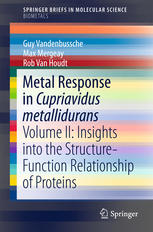

Most ebook files are in PDF format, so you can easily read them using various software such as Foxit Reader or directly on the Google Chrome browser.
Some ebook files are released by publishers in other formats such as .awz, .mobi, .epub, .fb2, etc. You may need to install specific software to read these formats on mobile/PC, such as Calibre.
Please read the tutorial at this link: https://ebookbell.com/faq
We offer FREE conversion to the popular formats you request; however, this may take some time. Therefore, right after payment, please email us, and we will try to provide the service as quickly as possible.
For some exceptional file formats or broken links (if any), please refrain from opening any disputes. Instead, email us first, and we will try to assist within a maximum of 6 hours.
EbookBell Team

0.0
0 reviewsThis book is the second volume of a two-volume set summarizing 40 years of key research findings directly related to metal-resistant Cupriavidus/Ralstonia (Betaproteobacteria). In this second volume, the structural and catalytic data from bacterial primary and secondary transporters (P-ATPases, tripartite chemiosmotic cation/proton efflux systems, cation diffusion facilitators, Major Facilitator Superfamily and some minor categories) are outlined and detailed for the corresponding C. metallidurans proteins. The available three-dimensional structures are reviewed in detail, including RND and membrane fusion proteins (from tripartite chemiosmotic cation/proton efflux systems), sigma and anti-sigma regulatory proteins of the cnr efflux system (resistance to cobalt and nickel) and various periplasmic proteins mainly involved in the response to copper and mercury. In addition, the first volume sketches the historical and geographical context of these bacteria, which are mostly found in industrial and polluted environments linked to zinc and other non-ferrous metallurgy, to illustrate the interactions between bacteria and human activities and the possible evolutionary consequences on bacterial genomes especially as far as the association of metal resistance genes with mobile genetic elements is concerned. It provides a detailed description of the response and underlying genetic determinants of type strain Cupriavidus metallidurans CH34 to a variety of metals. With high level resistance to cadmium, chromate, cobalt, copper, mercury, nickel, lead and zinc mediated by well-known genes for detoxification carried by its megaplasmids pMOL28 and pMOL30. This description is complemented with the genomic context of the metal response genes in C. metallidurans CH34 with a focus on its mobilome including insertion sequence elements, transposons, integrative and conjugative elements and genomic islands.